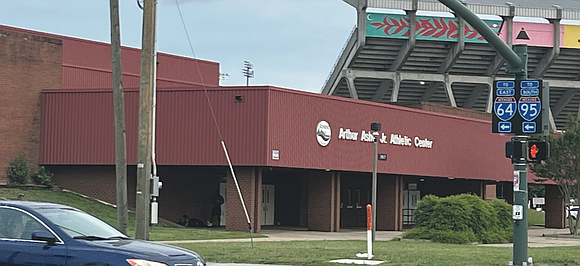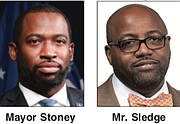School Board questions its role in Ashe Center’s site plans
Jeremy M. Lazarus | 5/26/2022, 6 p.m.
Another battle appears to be looming between City Hall and the School Board.
This time the issue involves the Arthur Ashe Jr. Athletic Center, which occupies a key four-acre parcel at the intersection of Arthur Ashe Boulevard and Robin Hood Road in North Side.
Mayor Levar M. Stoney’s administration wants to remove the aging 30-year-old building named for the tennis great as it is now part of the 67-acre largely city-owned Diamond District that is being pitched for redevelopment.
The Stoney administration has winnowed 15-teams down to three finalists and will soon recommend a winner of the potential $300 million to $500 million project that aims to create the equivalent of a small village of apartments, retail shops and offices anchored by a new baseball stadium that would replace The Diamond, which sits next to the Arthur Ashe Center.
The city holds the deed to the facility, but it was built as a basketball hub and convocation center for Richmond Public Schools, which has maintained control of the management and operations since the building opened in 1982.
At this point, the building remains in use, though a key portion of the air conditioning system no longer works.
Still, as the city moves forward, the School Board could become a sticking point, with members wanting the school system to get paid for giving up a building that the Stoney administration has no plans to replace. Leonard Sledge, Richmond’s development director, has ignored that wrinkle.
He has repeatedly told City Council that the city can do what it pleases with the building without reference to RPS, and no mention of the school system’s operational control of the Ashe Center has been included in any of the official city documents that were issued in seeking development teams.
The Stoney administration also has not mentioned any potential compensation to RPS in its plans for demolition, clearing and inclusion of the property in the Diamond District.
That does not sit well with the School Board. No one on the board has voiced any interest in standing in the way of the Diamond District redevelopment, but members also want to hear that that the city agrees that RPS is an interested party.
That view is based on both state law and a city ordinance that vests control of school property with the local School Board until that body votes to cede it back to the governing body’s control. And that appears to be the case under state law, no matter which entity holds the deed.
School board attorney, Jonnell P. Lilly of the Harrell and Chambliss law firm, told the board that she notified the city of the pending issue back in December, but has yet to receive a response.
Ms. Lilly said she will soon meet with City Attorney Haskell C. Brown III to learn whether the city believes that the board needs to “surplus” the building and issue a quitclaim deed to turn it back to the city.
That process has been followed in the past when the School Board gave up the use of a building and returned it the city, including the recent case of the former home of the REAL School.
Ms. Lilly said that if the School Board must vote, that would trigger a city ordinance that would require any proceeds from future sale of the property by the city to its chosen development team to be turned over to Richmond Public Schools.
And at current valuations of other parcels that have transferred on private land nearby the Diamond District, there are thoughts that RPS should reap $4 million to $8 million from the disposal of the Ashe Center site.
Ms. Lilly said the board would be able to determine its next step once she has that answer from Mr. Brown.
Jonathan Young, 4th District, who has chaired the board’s Vacant Property Committee, told his colleagues that there is a wealth of evidence to support the school system’s contention that it controls the building.
He noted that officials with the Richmond-Henrico Health District came to RPS for permission to use the building as a vaccination center, and that the city has sought RPS’s permission to use the building for an emergency shelter.
He and other members are concerned that the city might try to ignore that reality.
How the situation gets resolved is still up in the air.
“It’s going to be very, very interesting,” Mr. Young said.







